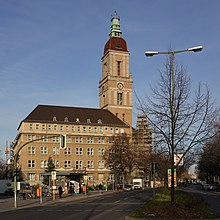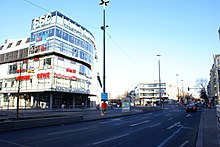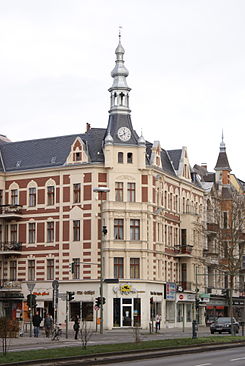Rheinstrasse (Berlin)
| Rheinstrasse | |
|---|---|
| Street in Berlin | |
| House on the Kaisereiche , corner of the Rhine and Schmiljanstrasse |
|
| Basic data | |
| place | Berlin |
| District | Friedenau |
| Created | around 1875 |
| Hist. Names | Provincial Chaussee Berlin – Potsdam |
| Connecting roads |
Hauptstrasse , Schloßstrasse |
| Cross streets |
Lauterstrasse , Schmargendorfer Strasse , Hedwigstrasse , Dickhardtstrasse (2 ×) , Schmiljanstrasse , Saarstrasse , Roennebergstrasse , Peschkestrasse , Bundesallee , Schöneberger Strasse |
| Places |
Breslauer Platz , Imperial Oak , Walther-Schreiber-Platz |
| Buildings |
Friedenau town hall , Goerz'sche Höfe |
| use | |
| User groups | Pedestrian traffic , bicycle traffic , car traffic , public transport |
| Technical specifications | |
| Street length | 1650 meters |
The Rhine Road is located in the Berlin district of Friedenau the district Tempelhof-Schöneberg . It is around one kilometer long and, as an arterial road, creates the connection between the city center and the southwestern districts of Berlin. The part of the former Provinzialchaussee Berlin – Potsdam was renamed in 1875 because of the connection between Berlin and the Rhine . The street was part of what was then Reichsstraße 1 and later Bundesstraße 1 .
course
The following course results from north to south:
The Rheinstrasse begins at Breslauer Platz , leads over the Kaisereiche and ends at Walther-Schreiber-Platz . It has a median across its entire length, which served as a route for the tramway running there until the 1960s and is now used for car parking bays between Walther-Schreiber-Platz and Kaisereiche. This former route is planted with greenery between Kaisereiche and Breslauer Platz. The M48 and M85 Metrobus routes run through Rheinstrasse along its entire course . The Wannseebahn and the main line run parallel to Rheinstrasse about 350 meters east .
From Breslauer Platz to the Imperial Oak
In continuation of the main street , Rheinstraße begins at Breslauer Platz. Here the following streets converge:

- Rheinstrasse,
- Main street ,
- Dickhardtstrasse ,
- Hedwigstrasse ,
- Schmargendorfer Strasse ,
- Lauterstraße and
- Niedstrasse .
Niedstrasse is also known as the “ Friedenau Literature Mile ” because numerous writers and literary figures - including Erich Kästner and the Nobel Prize winner Günter Grass - lived and worked on this street .
The town hall in Friedenau , built between 1913 and 1917 in Art Nouveau style by architect Hans Altmann, dominates Breslauer Platz . Since 1881 there has been a weekly market on Wednesdays, Thursdays and Saturdays on Breslauer Platz .
Along the entire length, the infrastructure for the local traders is a good opportunity for shopping. On this section, the traditional shop of the jeweler Lorenz , which has been in the fifth generation in Rheinstrasse 59 since 1874, and the Nicolaische Buchhandlung in the Rheinstrasse 65, which has existed here as a renowned institution steeped in tradition since 1929. There were two cinemas on this section until the 1960s: the Rheinschloß-Lichtspiele in Rheinstrasse 60 (now an organic market) and the Kronen-Lichtspiele in Rheinstrasse 65.
From the Imperial Oak to Breslauer Platz
The following roads converge at the Imperial Oak:
- Rheinstrasse,
- Schmiljanstrasse ,
- Moselstrasse ,
- Illstrasse and
- Saarstrasse .

The imperial oak owes its name to an oak that was planted on March 22, 1879 in honor of Kaiser Wilhelm I on the occasion of his golden wedding anniversary with his wife Augusta and his 82nd birthday. The oak had to be replaced on November 10, 1883, because the originally planted tree was badly damaged in protest against the socialist laws of Chancellor Bismarck at the time . The square was formerly known as the Rondell . There are no imperial oaks in the official street directories of the competent Tempelhof-Schöneberg district office . However, the BVG bus stop in the immediate vicinity of the traffic island is called that. The taxi rank on Rheinstrasse is also called “Kaisereiche”.
From the Kaisereiche, Rheinstrasse continues to Walther-Schreiber-Platz . Up until the 1960s, the Hohenzollern-Lichtspiele cinema was located just behind the Kaisereiche at Rheinstrasse 21 . Following the course of the street, numerous retail stores have also settled here, which represent a healthy mix and thus a relatively good infrastructure for Friedenau and the neighboring Steglitz .
Some of the local tradespeople who have come together in the "Rheinstrasse Initiative" organize joint advertising campaigns and several times a year the Rheinstrasse Festival , which extends as a street festival over the respective weekend and where the Rheinstrasse between Kaisereiche and Walther-Schreiber -Place is blocked for through traffic. This festival is viewed critically by some residents and traders because it does not correspond to the actual level of the Rheinstrasse.

On the eastern side behind Dickhardtstrasse in Rheinstrasse 45/46 are the Goerz'schen Höfe, the company premises of the optical institute C. P. Goerz , which has been based there since 1897 . The company manufactured cameras, lenses and telescopes and was known for its exemplary voluntary social services to its workers and employees. The brick buildings of the spacious industrial area with the towering factory chimney were built in several construction phases between 1897 and 1916 by the architects Paul Egeling , Waldemar Wendt, Emil Schmidt, Albert Paeseler and P. Mitnacht in the style of the modeled Renaissance and Gothic .
In 1926, the C. P. Goerz Optical Institute became part of Zeiss Ikon AG , which manufactured precision optical devices on Rheinstrasse. The commercial park can be viewed from Holsteinische Strasse at the rear, as there is no overall impression of the facility from Rheinstrasse. From 1908 to 1918 the Goerz Photochemical Works were located at Holsteinische Strasse 42 . In the second large courtyard, at the Rheinstrasse entrance, there is a large pulley from a freight elevator as an industrial monument. A large, sheet steel clad and roofed stage on a building in the rear part of the commercial area served the Goerz works. Today various businesses and offices are located on the property.
At the suburb of Steglitz , Rheinstrasse ends at Walther-Schreiber-Platz and continues as Schloßstrasse . Walther-Schreiber-Platz plays an important role as a traffic junction. Here the following streets converge:

- Rheinstrasse,
- Schlossstrasse ,
- Bundesallee ,
- Schöneberger Strasse
- Bornstrasse and
- Gutsmuthsstrasse .
The original square was rebuilt in 1971 on the occasion of the construction of today 's underground line U9 . The bus lanes and the taxi waiting lane were moved to the center of the square. In connection with the construction of the Schloss-Straßen-Center (SSC) , which opened at the end of March 2007 , the square was rebuilt so that the buses now stop at the roadside again. At the sharp corner between Bundesallee and Rheinstrasse (the so-called "Rheineck") is the listed building, in which the clothing store of the Ebbinghaus company was located, which traditionally had its headquarters in Friedenau (until 1962 it was domiciled in the Nied corner Lauterstraße on Breslauer Platz , i.e. at the other end of Rheinstraße). In this building today u. a. a medical center resident.
literature
- Gudrun Blankenburg: Friedenau - artist's place and idyllic residential area. The history of a Berlin district. 120 pages with more than 200 color illustrations and registers as well as the enclosed monument map of Friedenau. Frieling Verlag Berlin 2006, ISBN 3-8280-2350-9 .
- Alfred Bürkner: Friedenau - streets, houses, people . Stapp-Verlag, Berlin 1996, 232 pages, ISBN 3-87776-065-1 .
- Christel and Heinz Blumensath: The other Friedenau - walks through 125 years of art, literature and building history . District Office Schöneberg, Berlin 1996.
- Hermann Ebling: Friedenau. From the life of a rural community, 1871–1924 . Zinsmeister and Grass, Berlin 1986, ISBN 3-9801-3090-8 .
- Hermann Ebling, Evelyn Weissberg: Friedenau tells: Stories from a Berlin suburb - 1871 to 1914 , edition Friedenauer Brücke, Berlin 2007, ISBN 978-3-9811242-1-7 .
- Stefan Eggert: Walks in Schöneberg from the series Berlinische Reminiszenzen (No. 78) , Haude & Spener Verlag, Berlin 1997, ISBN 3-7759-0419-0 .
- Peter Lemburg, Gabriele Schulz, Dietrich Worbs: Monuments in Berlin, Schöneberg district, Friedenau district from the series monument topography Federal Republic of Germany , ed. from the Landesdenkmalamt Berlin and from the district office Schöneberg of Berlin. Verlag Willmuth Arenhövel, Berlin 2000, ISBN 3-922912-52-4 .
Web links
- Rheinstrasse. In: Street name lexicon of the Luisenstädtischer Bildungsverein (near Kaupert )
- Rheinstrasse Initiative Friedenau
Individual evidence
- ^ Walks in Schöneberg , S. Eggert, p. 58
Coordinates: 52 ° 28 ′ 8 ″ N , 13 ° 19 ′ 58 ″ E
